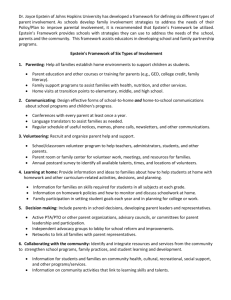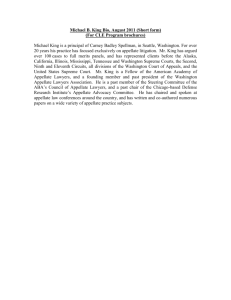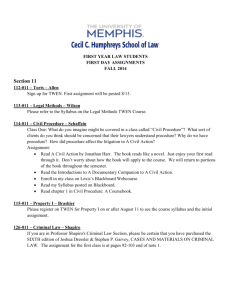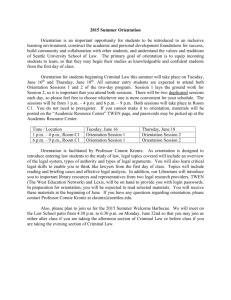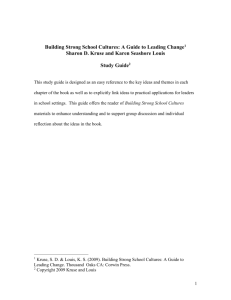Sloan Syllabus
advertisement
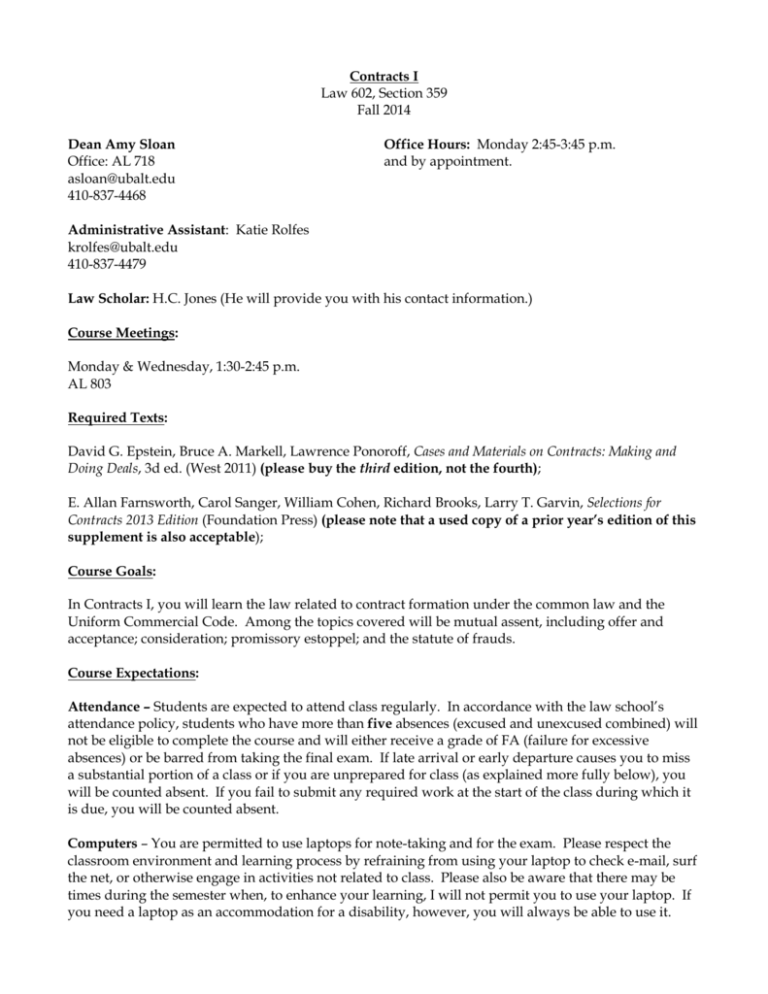
Contracts I Law 602, Section 359 Fall 2014 Dean Amy Sloan Office: AL 718 asloan@ubalt.edu 410-837-4468 Office Hours: Monday 2:45-3:45 p.m. and by appointment. Administrative Assistant: Katie Rolfes krolfes@ubalt.edu 410-837-4479 Law Scholar: H.C. Jones (He will provide you with his contact information.) Course Meetings: Monday & Wednesday, 1:30-2:45 p.m. AL 803 Required Texts: David G. Epstein, Bruce A. Markell, Lawrence Ponoroff, Cases and Materials on Contracts: Making and Doing Deals, 3d ed. (West 2011) (please buy the third edition, not the fourth); E. Allan Farnsworth, Carol Sanger, William Cohen, Richard Brooks, Larry T. Garvin, Selections for Contracts 2013 Edition (Foundation Press) (please note that a used copy of a prior year’s edition of this supplement is also acceptable); Course Goals: In Contracts I, you will learn the law related to contract formation under the common law and the Uniform Commercial Code. Among the topics covered will be mutual assent, including offer and acceptance; consideration; promissory estoppel; and the statute of frauds. Course Expectations: Attendance – Students are expected to attend class regularly. In accordance with the law school’s attendance policy, students who have more than five absences (excused and unexcused combined) will not be eligible to complete the course and will either receive a grade of FA (failure for excessive absences) or be barred from taking the final exam. If late arrival or early departure causes you to miss a substantial portion of a class or if you are unprepared for class (as explained more fully below), you will be counted absent. If you fail to submit any required work at the start of the class during which it is due, you will be counted absent. Computers – You are permitted to use laptops for note-taking and for the exam. Please respect the classroom environment and learning process by refraining from using your laptop to check e-mail, surf the net, or otherwise engage in activities not related to class. Please also be aware that there may be times during the semester when, to enhance your learning, I will not permit you to use your laptop. If you need a laptop as an accommodation for a disability, however, you will always be able to use it. Professionalism – You are expected to come to class on time and stay for the entire class unless you provide advance notice of your need to arrive late or leave early. You are also expected to come to class prepared to participate in the discussion or activities taking place during class time. If you are unprepared, please give me a note to that effect before class begins. If I call on you and you are not prepared and have not given me a note, you will be counted absent for that class period. Please be aware that being unprepared for class may negatively affect your final grade (as explained more fully below). In addition, please turn off your cell phone before class begins. TWEN – I will create a TWEN page for our class. You will receive a Westlaw password during orientation that you will need to access the TWEN page. I will communicate with the class through the TWEN page, and you are expected to check the site regularly for class announcements and course materials. Methods of Evaluation: Your grade in this class will be based primarily on the final examination at the end of the semester. Additional graded work may be assigned. The weight of any graded work will be announced when the assignment is made. I reserve the right to raise or lower a student’s grade by one half step (e.g., raise the grade from B to B+ or lower the grade from B to B-) based on class participation and preparedness. Syllabus: The following syllabus contains the schedule of reading assignments and topics for Contracts I. Although I don’t expect any major revisions, the syllabus is subject to change depending on our progress throughout the semester. Be sure to check for syllabus postings on TWEN to make sure you know the assignments for class. In the syllabus, the abbreviations Rest. and UCC refer to the Restatement (Second) of Contracts and Uniform Commercial Code provisions from the Farnsworth supplement. Cases that are not in the casebook (those listed by name only on the syllabus) and other materials will be posted under Course Materials on the course TWEN page. All reading is to be completed before class. Date 8/18 8/20 8/25 Topic Course introduction; mutual assent Mutual assent (continued) Offer Reading Case briefing handout (in this document after the syllabus) Epstein, 1-22 (through Note 5); & 36-47 (Lucy v. Zehmer) Rest. § 1 UCC § 2-102 Due in hard copy at the beginning of class: Case brief for Lucy v. Zehmer Epstein 47-55 & 58-66 (Leonard v. Pepsico; Smith v. Boyd; Problems on Mutual Assent) Epstein 66-69; 77-82 (Lonergan v. Scolnick; Note on Article 2) Lefkowitz (posted on TWEN) Rest. §§ 24, 26 UCC § 2-204 2 Date 8/27 Topic Destroying the offer 9/1 9/3 LABOR DAY Methods and timing of acceptance 9/8 Methods and timing of acceptances (continued) Content of acceptance; notice of acceptance Silence as acceptance; varying acceptance and counteroffers 9/10 9/15 and 9/17 9/22 Battle of the forms 9/24 9/29 10/1 TBA TBA Deficient and postponed agreements 10/6 Deficient and postponed agreements (continued) Intent to memorialize 10/8 10/13 and 10/15 Consideration: bargained for exchange Reading Epstein 83-85 (up to Dickinson); 90-96 Petterson v. Pattberg (posted on TWEN) Rest. §§ 35, 36, 38, 41, 42, 43, 48 NO CLASS Epstein 110-115; 123-126 (Ever-Tite Roofing v. Green; Maryland Supreme Corp.; Hendricks v. Behee) Rest. §§ 50(1), 30, 32, 60, 63, 65 UCC 2-206(1) Epstein 127-132 (Adams v. Lindsell; mailbox rule problems) Rest. §§ 50(1), 30, 32, 60, 63, 65 UCC 2-206(1)(a) Epstein 132-138; 142 (Carlill v. Carbolic Smoke Ball; Problems on Acceptance) Rest. §§ 54(1); 56 Ammons v. Wilson (posted on TWEN) Epstein 146-154 (Gresser v. Hotzler up to Part II of the opinion on p. 151 only and then the notes following the case) Minneapolis & St. Louis Railway Co. v. Columbus Rolling-Mill Co. (posted on TWEN) Rest. §§ 58, 59, 61; 39; 69 We will need two classes to get through all of this material, but please read all of it together. Epstein 154-164 (Dorton v. Collins & Aikman) UCC 2-207 TBA TBA Epstein 180-192 (The Peerless Case; Introduction to Varney; Varney v. Ditmars) Rest. § 33 We will only touch briefly on The Peerless Case MGM v. Scheider; Martin’s Deli v. Schumacher (posted on TWEN) Epstein 195-198 (Notes) Rest. § 26 UCC §§ 2-204(3); 2-305(1) Epstein 212-218; 221-224 (text beginning below the line mid-page; Budget Marketing, Inc. v. Centronics Corp. up to Part II of the opinion only and then the notes following the case) Rest. § 27 Epstein 225-247 (Reed v. UND; Kirksey v. Kirksey; Hamer v. Sidway; Schnell v. Nell) Additional reading will be posted on TWEN. Rest. § 71 We will need two classes to get through all of this material, but please read all of it together. 3 Date 10/20 10/22 10/27 10/29 11/3 11/5 Topic Consideration: waiver of claims Consideration: illusory promises Consideration: contract modification; moral obligation Consideration: moral obligation (continued) TBA Alternatives to consideration: promissory estoppel 11/10 Options, firm offers, and bids 11/12 Statute of frauds: introduction and coverage Statute of frauds: compliance 11/17 11/19 11/24 TBA Review session Reading Fiege v. Boehm (posted on TWEN) Rest. § 74 Epstein 247-253 (Hooters of America v. Phillips) Wood v. Lucy, Lady Duff-Gordon (posted on TWEN) Rest. § 77 UCC § 2-306 Epstein 253-266 (Alaska Packers v. Delmonico; Angel v. Murray; Harrington v. Taylor) Rest. §§ 73, 89 UCC § 2-209(1) Epstein 266-278 (Mills v. Wyman; Webb v. McGowin) Rest. § 86 TBA Epstein 278-279 ; 284-300 (Overview; Dargo v. Clear Channel; Fortress Systems v. Bank of the West; Notes on promissory estoppel) SKIP Part 2 of Fortress Systems on the statute of frauds. Rest. §§ 2, 90(1) Epstein 96-101; 104-106; 301-315 (Beall v. Beall; Notes on option contracts; Pavel Enterprises v. A.S. Johnson) Rest. § 87 UCC § 2-205 Epstein 323-325 General Federal Construction v. Federline (posted on TWEN) UCC § 2-201(1)-(2) Epstein 325-330 (Radke v. Brenon) Elizabeth Arden Sales Corp. (posted on TWEN) Rest. §§ 131, 132, 133, 134, 136 TBA Review all notes 4 Case Briefing Adapted from materials by Professors Byron Warnken and Elizabeth Samuels What is a Case Brief? A case brief is an analytical summary of a judicial opinion. It is a method of taking notes on cases assigned for class. (A case brief should not be confused with a legal brief submitted by an attorney to a court.) The process of preparing a case brief can help you understand the case, and the completed brief can be a valuable document for preparing for class, analyzing cases in class, reviewing after class, making outlines in preparation for exams, and studying for exams. The appropriate length of a case brief is a function of the complexity of the case, the sophistication of the briefer, and the purposes for which the brief is made. Briefing style and briefing length evolve rapidly during the first semester of law school. During the first month of law school, in particular, you should review briefs that you prepare for quality and length. If upon subsequent review, you need to “brief the case brief” in order to have a workable study tool, then the case brief is too long. On the other hand, if upon subsequent review, the case brief does not contain enough information to permit sufficient recall of the case, the case brief is too short. There may be as many briefing techniques as there are briefers. This document discusses one briefing technique. You may hear about other techniques during orientation, from your other professors, or from fellow students. This is fine. There is no single right way to brief a case. You should experiment with different briefing styles until you find a method that helps you understand the assigned cases and follow and participate in class discussion. For the most part briefs will be your notes for your use to help you understand the material. Unless specifically instructed to do so, you are not expected to submit case briefs for this class. The Components of a Case Brief A comprehensive brief of a case contains the following eleven components: (1) Citation: At a minimum, every case brief should note (1) name of the case, (2) the jurisdiction and name of the court, and (3) the year of decision. Depending on the purpose of the brief, you may also want to include a complete legal citation, which is an abbreviation identifying where the case is published. (2) Parties: The parties to the case are the litigants. Each party can usually be identified by one or more factual categorizations, e.g., employee, agent, landlord, offeree, the State. In addition to identifying the parties’ factual status, you need to determine their litigation status. For example, at the trial level, it is usually a plaintiff versus a defendant, or the State (or Commonwealth or People) versus a defendant. At the appellate level, it is appellant versus appellee or petitioner versus respondent. (3) Relief sought: What was the legal objective or result sought by the party seeking relief? This could be money damages or dismissal of the suit or remand for a new trial. If you are reading an appellate case, the party seeking relief may not be the party who initiated the suit in the first instance. In an appellate case, the party seeking relief usually seeks a reversal of the decision of a lower court, either a vacating of the judgment or a modification of the legal result at the trial level. 5 (4) Procedure: Understanding the procedural history and current procedural posture of every case is essential. The case brief should list all procedural steps, from the initial proceeding through the present proceeding. Each step in the procedural history of the case should be identified by (a) the nature or type of proceeding, e.g., a civil tort case, a divorce action, a suit for an injunction, a criminal case, (b) the party initiating that step in the proceeding, and (c) in an appellate case, the tribunal that resolved the matter below. There may be many steps in the procedural history of the case, or there may be only one. Most judicial opinions you read in law school are written by appellate courts. Thus, there is usually at least one prior level in the procedure, i.e., the trial level below, plus the current procedural posture, i.e., the current appeal. Many of the terms used to describe procedural steps in the litigation may be unfamiliar to you, so don’t be surprised if you need to use a legal dictionary to try to understand the procedural steps that led to the opinion you are reading. (5) Legal theories: Any time that a party seeks relief, that litigant must have a legal basis for his or her objective. At the trial level in a civil case, the party seeking relief must have one or more “causes of action.” The legal theory of the other party, in either a civil or criminal action, is referred to as a defense, which is usually in the form of a general denial (e.g., “I did not commit the offense,” or “I did not breach the contract,”) or in the form of an assertion of one or more affirmative defenses (e.g., “If I committed the offense, it was done in self-defense or was done under duress”). At the appellate level, the party seeking relief, who is the appellant or petitioner, usually bases the appeal upon a claim that the trial court has made one or more errors of law. The party seeking to uphold the lower court’s decision, the appellee or respondent, usually contends that the trial judge made no legal errors or that if the trial judge did make a legal error, the error does not require reversal. (6) Legally significant facts: Because like cases should be decided in like manner under the principle of stare decisis, it is necessary to understand the facts of the case to which the law has been applied. You must determine which facts were significant to the court in reaching its result. Legally significant facts are also referred to as operative facts, key facts, material facts, and salient facts. Facts are determined at the trial level. Evidence is produced by the litigants, and the facts are ascertained by the “finder of fact,” also referred to as the “trier of fact.” If three prosecution witnesses testify that they saw the defendant shoot the victim, and three defense alibi witnesses testify that the defendant was playing pool with them at Joe’s Bar and Grill at the time of the murder, it is the finder of fact who will decide where the defendant was and what he did. The finder of fact will be either a jury, in a jury trial, or a judge, in a non-jury trial. A non-jury trial is also referred to as a court trial or bench trial. As you read an appellate opinion, you will learn the facts solely from the appellate court, which is not the fact finder. To determine what facts were found below, the appellate court relies on the record of the case, including the evidence submitted by the parties and the written decision of the lower court. Your understanding of the appellate court’s understanding of the facts is crucial. Certain signals in the court’s opinion will help you understand what the court understands to be the facts found below: (a) The appellate court states that the record directly supports certain facts. (b) The appellate court states that certain facts can be inferred from the record. (c) The appellate court states that certain facts were agreed upon or stipulated to by the parties. (d) The appellate court accepts allegations of one of the parties that certain facts exist. 6 It is also helpful to consider indications of what facts the appellate court determines the court below found did not exist: (a) The appellate court expressly states or implies that certain facts do not exist. (b) The appellate court rejects allegations made by one or more of the parties that certain facts exist. A fact is legally significant if altering or eliminating that fact would change the legal conclusion or result of the case. Because facts gain their legal significance only in light of the controlling law, the relevant factual categories depend upon the legal issues. Thus, the same facts may acquire or shed their legal significance depending upon the issue. Assume that a case involves a green 1981 Chevrolet Camaro, with the serial number 6857109. “Green,” “1981 Chevrolet Camaro,” and “serial number 6857109” may all be irrelevant, and the legally significant fact may be “automobile,” if the issue is the automobile exception to the requirement for a search warrant under the Fourth Amendment. “Green” and “serial number 6857109” may both be irrelevant, and the legally significant fact may be “1981 Chevrolet Camaro,” if the issue is an automobile recall. “Serial number 6857109” may be irrelevant, and the legally significant fact may be “green 1981 Chevrolet Camaro,” if the issue is an eyewitness identification of the getaway vehicle in a robbery. When evaluating facts for legal significance, you must evaluate the facts of the case as a totality to the extent possible. (7) Issue(s): An issue is a question of law. It is usually a question that asks, “What is the result when you apply this rule of law to these facts?” A case will always present at least one issue and may contain multiple issues. Sometimes, but not always, the court will specifically identify the issue or issues it is addressing in the opinion. An issue can usually be framed in the form of a question that can be answered “yes” or “no.” In order to yield a legal conclusion that can be applied under the principle of stare decisis to future similar situations, the issue must be stated neither too narrowly nor too broadly. An example is included below to illustrate this point. Issues should have two components -- one legal and one factual. The legal component should identify the relevant rule of law. The factual component includes facts legally significant to the issue. Depending on the nature of the legal question, the issue might read as follows: “Do [legally significant facts] constitute [particular portion of the rule of law] within the meaning of [the rule of law]?” Several examples follow. A. Well-framed issue: Is a person who does not register brain waves a human being for purposes of common law murder, which is the felonious killing with malice of a human being? B. Inadequate factual component (no factual category or factual category too narrow): Is Mr. Jones is a human being for purposes of common law murder, which is the felonious killing with malice of a human being? C. Inadequate factual component (factual category too broad): Is a person with no chance of recovery a human being for purposes of common law murder, which is the felonious killing with malice of a human being? D. Inadequate legal component (no rule of law): Is a person who does not register brain waves alive? 7 In examples B and C, the rule of law is provided but nothing is known about Mr. Jones. An answer of “yes” or “no” will not be helpful because there will be no way to consider whether the next set of facts is sufficiently similar to dictate the same answer. In the second example, the facts are stated too broadly. Even if the answer is “yes” to the well-framed issue, it could only be “maybe” to this issue because “an individual with no chance of recovery” is broad enough to include a terminally ill person, who also has no chance of recovery but who is a human being for purposes of common law murder and in every other legal context. In example D, the person may no longer be a human being from the standpoint of common law murder, but he may still be a human being and still be very much alive from the standpoint of contract law or the law of trusts and estates. While he may no longer be a potential murder victim, his life insurance policy beneficiary may not be able to collect and his estate may not be subject to probate. (8) Holding(s): A holding is a conclusion of law. It is generally the affirmatively stated “yes” or “no” answer to the legal issue, to the question that asks, “What is the result when you apply this rule of law to these facts?” (9) Court’s rationale: The court’s rationale consists of both its reasons and its policy considerations. While the holding provides the “what,” the rationale provides both the “how” and the “why.” If every case that arose thereafter were exactly the same as the case being briefed, then knowing the “what” would probably be enough. However, because later cases will not be exactly “on point,” or “on all fours” with the present case, it is necessary to understand the court’s rationale in order to consider how the law of the case may be applied to future cases. (10) Dictum: Obiter dictum, usually shortened to dictum, is Latin for “a remark by the way.” It is “an observation or remark made by a judge in pronouncing an opinion upon a cause, concerning some rule, principle, or application of law, or the solution of a question suggested by the case at bar, but not necessarily involved in the case or essential to its determination; any statement of the law enunciated by the court merely by way of illustration, argument, analogy, or suggestion. Statements and comments in an opinion concerning some rule of law or legal proposition neither necessarily involved nor essential to determination of the case in hand are obiter dicta, and lack the force of an adjudication.” Black’s Law Dictionary 541 (6th ed. 1990) (citation omitted). Dictum often takes one or more of the following forms. (a) The court may analyze facts different from those before the court, e.g., “Had the bicycle been a motor bike, our conclusion would be different.” (b) The court may analyze rules of law not necessary to resolve the issues before the court, e.g., “Had this cause of action arisen today, under the amended statute, the claimant would be entitled to benefits.” (c) The court may analyze an issue not before the court, e.g., “Although the question is not raised by this case, it appears that the statute would have precluded coverage had the injury occurred on the first day of employment.” (d) The court may analyze an issue not necessary to resolve in light of the resolution of one or more threshold issues, e.g., “While reversing the judgment below and remanding for a new trial because of the erroneous admission of evidence, we note that the award of punitive damages could not have withstood appellate review because this is not a case of pure tort but a case of tort arising out of contract.” It is essential to distinguish holding from dictum -- the former is the law, the latter may or may not be the law but is certainly not the law of the case. (11) Separate opinions: Separate opinions are extra opinions that are written by individual judges and are not the opinion of the court. These opinions are either concurring or dissenting ones and do not contain the court’s holding. The author of a concurring opinion agrees with the majority’s disposition of the case but for different reasons, for additional or more expansive reasons, or for fewer 8 or more limited reasons. The author of a dissenting opinion disagrees with the majority’s disposition of the case. If the case you are reading has any separate opinions, they should be summarized and analyzed. Quotations from Cases When you are first learning to brief cases, it is tempting to quote extensively from the court’s opinion. After all, what could be better than the court’s own words? Quoting extensively from the case, however, defeats the purpose of a case brief. A case brief should summarize and analyze the opinion in a way that helps you understand the principles of law. Cutting and pasting from an opinion does not require the same degree of intellectual work that explaining the case in your own words does. You should use quotations sparingly, only when it is absolutely necessary to repeat the court’s language, such as when you must note the exact wording of a legal test or standard. Often, students quote the language of the opinion when they don’t really understand what the opinion means and are, therefore, unable to put the ideas in their own words. If you find yourself quoting extensively, ask yourself whether you really understand the case. If you do, try to put the elements of the case into your own words. If you don’t, keep reading the case until you do understand it. 9
